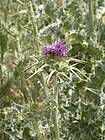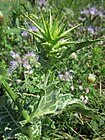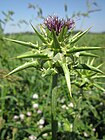Note: This is a project under development. The articles on this wiki are just being initiated and broadly incomplete. You can Help creating new pages.
Silybum marianum - Milk thistle
Milk thistle is a genus of two species of thistles in the daisy family. The plants are native to the Mediterranean regions of Europe, North Africa, and the Middle East. One species has been introduced elsewhere, including in North America.
Contents
- 1 Uses
- 2 Parts Used
- 3 Chemical Composition
- 4 Common names
- 5 Properties
- 6 Habit
- 7 Identification
- 8 List of Ayurvedic medicine in which the herb is used
- 9 Where to get the saplings
- 10 Mode of Propagation
- 11 How to plant/cultivate
- 12 Commonly seen growing in areas
- 13 Photo Gallery
- 14 References
- 15 External Links
Uses
Chronic hepatitis, Cirrhosis of the liver., Diabetes, Liver disorders, Skin eruptions, Blotches, Pimples, Diarrhea, Sore throats
Parts Used
Young stalks, Leaves, Roots, Flowers.
Chemical Composition
Silymarin, a flavonoid complex that can be extracted from the seeds of milk thistle, is composed of three isomers7. Silymarin is typically extracted with 95% ethanol, yielding a bright yellow fluid, although one of the most studied and used milk thistle products, Legalon® (Madeus, Germany), is prepared via extraction with ethyl acetate[1]
Common names
| Language | Common name |
|---|---|
| Kannada | |
| Hindi | |
| Malayalam | |
| Tamil | |
| Telugu | |
| Marathi | NA |
| Gujarathi | NA |
| Punjabi | NA |
| Kashmiri | NA |
| Sanskrit | |
| English | Milk thistle |
Properties
Reference: Dravya - Substance, Rasa - Taste, Guna - Qualities, Veerya - Potency, Vipaka - Post-digesion effect, Karma - Pharmacological activity, Prabhava - Therepeutics.
Dravya
Rasa
Tikta (Bitter), Kashaya (Astringent)
Guna
Laghu (Light), Ruksha (Dry), Tikshna (Sharp)
Veerya
Ushna (Hot)
Vipaka
Katu (Pungent)
Karma
Kapha, Vata
Prabhava
Habit
Identification
Leaf
| Kind | Shape | Feature |
|---|---|---|
| Simple | The leaves of the milk thistle are oblong to lanceolate in shape |
Flower
| Type | Size | Color and composition | Stamen | More information |
|---|---|---|---|---|
| Unisexual | 4 and 12 cm | Yellow | 5-20 | Milk thistle flower heads average between 4 and 12 cm. long and wide, and are light purple in colour |
Fruit
| Type | Size | Mass | Appearance | Seeds | More information |
|---|---|---|---|---|---|
| General | 7–10 mm | clearly grooved lengthwise, Lowest hooked hairs aligned towards crown | - | - | {{{6}}} |
Other features
List of Ayurvedic medicine in which the herb is used
Where to get the saplings
Mode of Propagation
How to plant/cultivate
Milk thistle (Silybum marianum L. Gaertn.) is the most researched plant for the treatment of liver disease. Its therapeutic properties are due to the presence of silymarin, a mixture of three flavonolignans (silybin, silydianin and silycristin).[3]
Commonly seen growing in areas
Mediterranean regions, Meadows, Borders of forests.
Photo Gallery
References
External Links
- Ayurvedic Herbs known to be helpful to treat Chronic hepatitis
- Ayurvedic Herbs known to be helpful to treat Cirrhosis of the liver.
- Ayurvedic Herbs known to be helpful to treat Diabetes
- Ayurvedic Herbs known to be helpful to treat Liver disorders
- Ayurvedic Herbs known to be helpful to treat Skin eruptions
- Ayurvedic Herbs known to be helpful to treat Blotches
- Ayurvedic Herbs known to be helpful to treat Pimples
- Ayurvedic Herbs known to be helpful to treat Diarrhea
- Ayurvedic Herbs known to be helpful to treat Sore throats
- Herbs with Young stalks used in medicine
- Herbs with Leaves used in medicine
- Herbs with Roots used in medicine
- Herbs with Flowers used in medicine
- Herbs with common name in English
- Habit - Biennial plant
- Index of Plants which can be propagated by Seeds
- Index of Plants which can be propagated by Cuttings
- Herbs that are commonly seen in the region of Mediterranean regions
- Herbs that are commonly seen in the region of Meadows
- Herbs that are commonly seen in the region of Borders of forests
- Herbs
- Ayurvedic herbs that don't have seed photos
- Asteraceae





